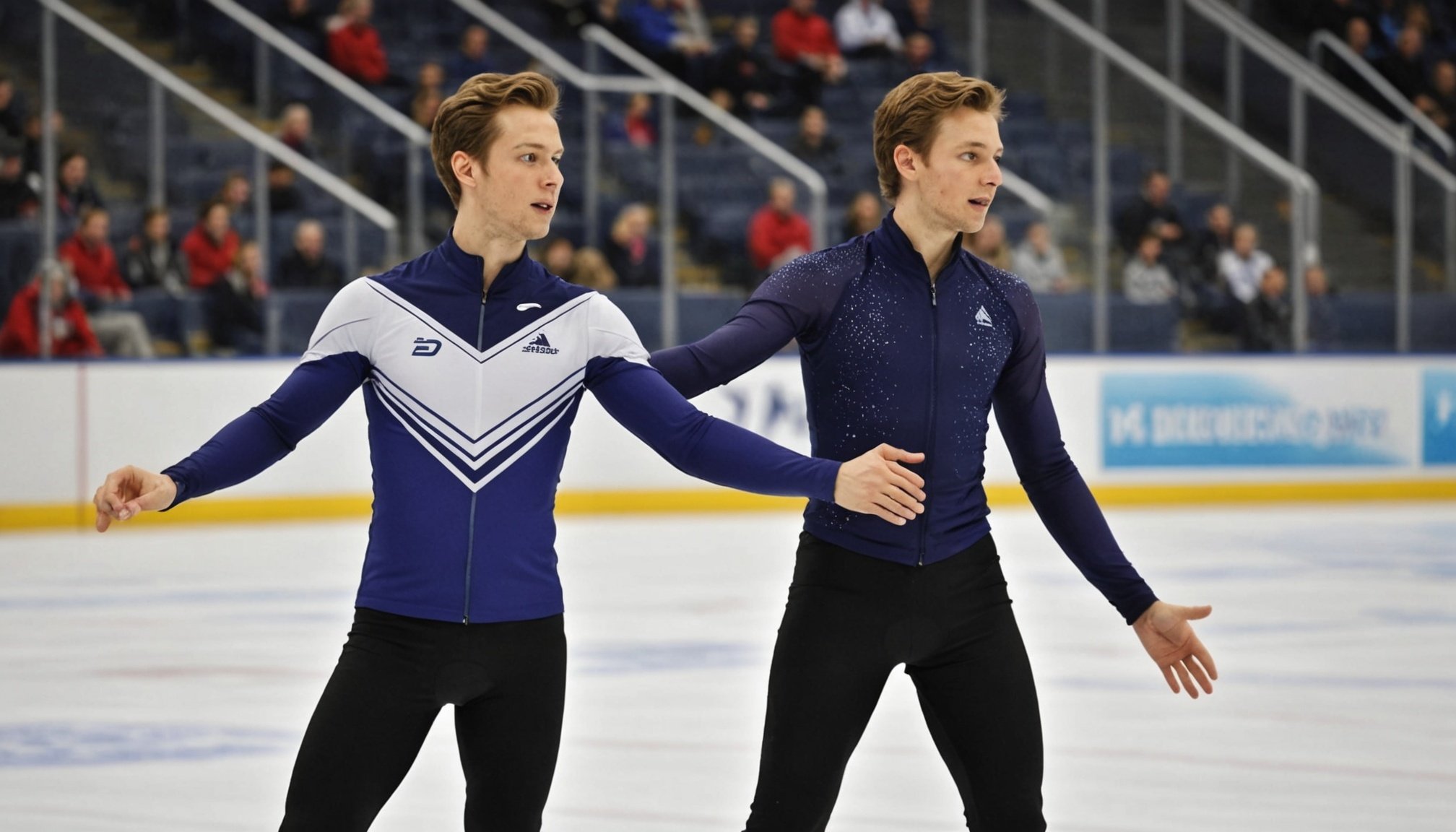Overview of Cross-Training for Figure Skaters
Cross-training is essential in figure skating performance, offering a diverse set of exercises which enhance athletic ability. Cross-training techniques improve various physical attributes beyond traditional practice. Flexibility, endurance, and strength are targeted through these methods, providing skaters with comprehensive development.
Key Physical Attributes
Cross-training techniques primarily focus on enhancing core strength, flexibility, endurance, balance, and agility. This multidimensional approach helps skaters achieve a well-rounded athletic profile. Core stability, for instance, is pivotal in executing complex skating maneuvers and preventing injuries. Flexibility is crucial for graceful movements, while endurance ensures stamina during routines.
Additional reading : Unlocking Athletic Resilience: Proven Tactics to Triumph Over Major Sports Setbacks
Benefits of Cross-Training
The benefits of cross-training are manifold. For athletes, it reduces injury risk by varying strain on muscles and joints, improving overall resilience. It also breaks the monotony of regular training, keeping motivation levels high. For skaters, these workouts can translate into improved jumps, spins, and artistry on the ice. Integrating different training modalities helps address weaknesses, ultimately leading to better performance and competitive success.
Strength Training Techniques
Strength training is a key component of enhancing figure skating strength, essential for performing powerful moves on the ice. It encompasses various exercises that focus on building muscle power and endurance, allowing skaters to execute demanding routines with ease. Engaging in exercises like squats and deadlifts can significantly boost muscle power for jumps and lifts.
Have you seen this : Top nutritional boosts every swimmer should focus on during heavy training sessions
Squats enhance lower body strength, crucial for explosive lift-offs during routines, while deadlifts develop posterior chain muscles, improving overall posture and stability. Exercises such as these not only fortify muscle groups essential for skating but also aid in injury prevention.
Designing a personalized strength training routine involves understanding individual needs and limitations. Skaters should consider consulting with a coach to tailor exercises that complement their specific training regimens. It’s important to progressively increase the training’s intensity, ensuring steady muscle development without risking strain or injury.
To effectively incorporate strength training into a skater’s routine, periodization—a systematic planning of training phases—is crucial. This approach helps optimize performance and maintain peak physical condition throughout the competitive season. Consistent effort and progressive adaptations ensure that strength training maximizes benefits for figure skating performance.
Flexibility and Stretching Regimens
In figure skating, flexibility training is not just beneficial; it’s indispensable. Seamless, graceful motions executed during routines demand a high degree of flexibility. Engaging in specialized stretching exercises aids skaters in achieving the fluidity necessary for top-tier performances.
Effective stretching techniques are diverse. Dynamic stretching, such as leg swings, prepares muscles for the explosive demands on the ice. Conversely, static stretching, like hamstring or quadriceps stretches, enhances muscle elasticity, reducing injury risks post-performance.
Creating a flexibility routine requires careful consideration. It should balance dynamic and static stretching exercises tailored to individual needs, ensuring comprehensive coverage of muscle groups integral to skating. Skaters must remember the importance of consistency; regular practice weaves flexibility into the body’s fabric, fortifying it against the strains of intense routines.
Guided sessions, whether through a coach or digital platforms, can illuminate the correct form and sequence of exercises. Such resources help skaters develop personalised stretching regimens that evolve alongside their skills, maximising the impact on their skating artistry. This foundational aspect of training fosters an essential versatility, enabling skaters to excel and captivatingly present each performance.
Endurance and Cardio Workouts
Endurance is crucial for competitive figure skating, ensuring skaters perform at peak levels throughout routines. To build stamina, incorporating cardio workouts into training regimens is essential. Endurance training focuses on aerobic exercises that maintain a skater’s energy and improve cardiovascular health.
Cardio workouts such as running, cycling, and swimming are excellent for enhancing endurance. These activities elevate the heart rate, increasing the lungs’ capacity to supply oxygen to working muscles. Over time, regular cardio workouts can help skaters achieve a greater capacity for sustained effort on the ice.
Integrating endurance training into a skater’s routine can involve a mix of long-duration and interval-based exercises. For example, long-distance running can enhance base endurance, while high-intensity interval training (HIIT) can improve short bursts of power—necessary for quick recoveries in back-to-back elements.
Skaters should aim to balance cardio with other training components, ensuring a comprehensive approach to physical development. Scheduling regular cardio sessions and varying the activities can prevent burnout and keep sessions engaging. By prioritizing endurance, skaters are better positioned to maintain poise and energy throughout their performances.
Balance and Agility Drills
Balance and agility are fundamental in achieving excellence in figure skating. These elements enable precise movements and quick adaptations needed during performances. Focused balance training can significantly impact overall stability and control.
Balance training might include drills such as using wobble boards or balance balls to challenge stability. Hopping exercises on one leg train skaters to maintain equilibrium under dynamic conditions. These activities are designed to enhance foundational stability, critical for executing spins and landings with precision.
Agility exercises improve quickness and coordination, vital for fluid transitions between movements. Ladder drills, cone drills, and lateral hops can sharpen a skater’s ability to swiftly change direction and evade obstacles. Agility not only boosts competitive readiness but also enriches the artistic quality of a routine.
Incorporating these drills consistently into training regimens ensures skaters develop the nimbleness required for demanding performances. Balance and agility training should be tailored, and regularly evaluated, to accommodate individual progression and specific competitive goals. By integrating these exercises, skaters are better equipped to sustain their competitive edge.
Core Stability Exercises
Core stability is vital for supporting the complex maneuvers seen in figure skating. This stability encompasses the muscles in the abdomen, lower back, and pelvis, which are pivotal for maintaining balance and executing controlled movements.
Core Exercises Tailored for Figure Skaters
-
Planks: Engaging in plank exercises can significantly enhance core endurance and strength. This simple activity targets multiple muscle groups, providing a solid base for skating techniques.
-
Medicine Ball Routines: Using a medicine ball introduces resistance, helping to develop rotational core strength necessary for spins and jumps.
Both exercises aim to reinforce the physical foundation needed for precise movements on the ice.
Integrating Core Stability Work
Incorporating core training into regular practice requires a strategic approach. Consider adding core exercises at the beginning or end of a session to ensure muscles are warmed up or to calm down respectively. Creating a diversified regimen with different exercises can maintain interest and focus.
Consistency is key. By routinely focusing on core stability, skaters can achieve improved posture, enhanced balance, and robust support for their on-ice performances, ultimately elevating their figure skating abilities.
Expert Insights and Testimonials
In the realm of figure skating, insights from professionals provide valuable guidance for athletes aiming to optimize their training regimens. Coaches emphasize the importance of holistic approaches, incorporating diverse cross-training techniques to bolster overall performance.
Many competitive figure skaters offer compelling testimonials about their experiences with cross-training. Athletes report improvements in agility and endurance, attributing their competitive successes to these supplementary practices. For instance, skaters who incorporated balance training reported heightened stability during routines, enhancing their execution of intricate moves.
The impact of cross-training on performance is evident in the increase of successful outcomes. Cross-training not only augments physical capacities but also enriches mental focus, fostering better control during competitions. These experiences underline that well-rounded fitness routines contribute significantly to artistic and technical proficiency on the ice.
Incorporating expert advice and learning from experienced skaters ensures that athletes can achieve comprehensive development. By heeding the experiences and success stories of professionals, skaters can enhance their understanding and implementation of effective cross-training strategies, ultimately paving the way for sustained competitive triumphs.
Integration of Cross-Training Techniques into Practice
Integrating cross-training techniques into figure skating practices can elevate overall performance. Effectively merging different exercises requires careful planning to balance skating-specific skills with cross-training benefits. A strategic approach emphasises periodization—a method that structures training phases to optimise gains throughout the competitive season.
Periodization involves cycles of varying intensity and focus, which help manage fatigue and promote peak physical condition when it matters most. During off-season periods, heavier strength and endurance building may dominate, transitioning to skill refinement as the competitive season approaches.
Maintaining motivation and consistency is crucial. Diversifying routines by incorporating various cross-training elements keeps sessions engaging and prevents burnout. Encouragement from coaches should also highlight progression, as recognising improvements fosters commitment.
Regularly reviewing and adjusting training regimens ensures they align with individual goals and competition schedules. This dynamic approach not only sustains interest but continually challenges athletes to progress, empowering skaters to maximise the benefits of cross-training. Overall, a well-integrated practice plan not only supports physical adaptations but enriches the mental resilience necessary for competitive success.
Additional Resources and Tools
In today’s digital era, access to cross-training resources is easier than ever for figure skaters aiming to enhance their training routines. Online platforms provide a wealth of exercise videos that demonstrate effective techniques—even for those practicing independently. These tutorials can inspire and guide skaters in incorporating new exercises into their routines, ensuring they undergo constant development.
Not only are digital resources beneficial, but training tools such as mobile apps offer precise tracking for workout progress. Apps designed for athletes typically feature customizable parameters to monitor time, repetitions, and progress over intervals, allowing skaters to reflect on their advancement. This insight fosters a structured approach to achieving specific goals.
For coaches and skaters committed to refining their figure skating performance, embracing a culture of continuing education is vital. Exploring the latest research studies or attending webinars can unveil cutting-edge techniques and industry trends, ensuring that their strategies remain both current and effective. This proactive educational pursuit ultimately enriches the benefits of cross-training by equipping users to fully leverage available tools, leading to sustained improvement.











